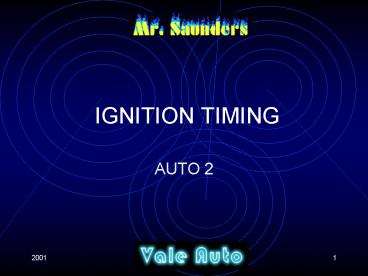IGNITION TIMING - PowerPoint PPT Presentation
1 / 32
Title:
IGNITION TIMING
Description:
IGNITION TIMING AUTO 2 Ignition Timing Timing wasn t adjustable on your Briggs & Stratton's Engines were designed to run at a steady governed speed so timing was ... – PowerPoint PPT presentation
Number of Views:1457
Avg rating:3.0/5.0
Title: IGNITION TIMING
1
IGNITION TIMING
- AUTO 2
2
Ignition Timing
- Timing wasnt adjustable on your Briggs
Stratton's - Engines were designed to run at a steady governed
speed so timing was set at factory to work best
at that speed - An Automobile needs good power and fuel
efficiency at all driving speeds so timing needs
to be changed to meet all these demands
3
Ignition Timing
- Time it takes to burn an A/F mixture depends on
- Compression ratio
- Mixture (ratio mixed up)
- Combustion chamber shape and size
- Placement of spark plug in chamber
- Throttle opening RPM
- Other small factors
4
Ignition Timing
- Engineers generally agree that we need the
biggest push down on the average piston around
23o ATDC
5
Overadvanced Timing (too soon)
- Causes
- Detonation
- Second explosion of A/F after plug lights
- Hard cranking (balking)
- More of one type of emission
6
Retarded Timing (too late)
- Causes
- Low Power
- Less efficiency (mpg)
- More emissions
- Backfiring out the throttle plate
- Lower engine vacuum (manifold)
- Higher cylinder temperature
- Hotter running engine
7
Ignition Timing
Lets say this engine is running at 1650
RPM (write it down by the picture)
23o
Lets say this engine takes 4 mS to burn the A/F
to get good pressure and we want the big push at
23o ATDC
8
Ignition Timing
- At 1650 RPM, how far is the crankshaft going to
move during 4 mS (.004 seconds)? Think think
think thinkkkkkk, how am I going to do this? - Lets get RPM to RPS
- 1650 divided by 60 27.5 RPS
- There are 360o in a circle so
- 360 times 27.5 about 10,000o per second of
crank - There are 1000 mS per second so
- 10,000 divided by 1000 10o per mS
- 10o per mS times 4 mS 40o
I got it, At 1650 RPM the crank will move about
40o in 4 mS
9
Ignition Timing
40o
Calculate how many degrees before TDC the spark
will need start to get the big push at 23o ATDC
10
Ignition Timing
- Now take the same engine and rev it up to 2500
RPM and say it still takes 4 mS to get the good
burn and push on the piston. - If we leave the starting point at 17o BTDC the
BIG PUSH will happen too late - Lets calculate
11
Ignition Timing
2500 divided by 60 41.66 RPS
41.66 times 360 15,000 degrees per second
15,000 divided by 1000 15 degrees per mS
15 times 4 mS 60 degrees
Calculate when the big push will Happen and fill
in on drawing
12
Ignition Timing
- So what we need to do is to advance the starting
point when we rev up the engine - Copy the numbers from your top engine over to the
top engine on the next page in your notebook
13
Ignition Timing
17o BTDC
40o
At 1650 RPM
14
Ignition Timing
If we are going to maintain the big push at 23o
ATDC at 2500 RPM, Calculate where we are going to
have to advance the timing too?
23o
15
Ignition Timing
- So when we speed the engine up, we will need to
have the spark take place sooner - We are not going to change the dwell
- Specifications needed to maintain proper
saturation time and point opening - So how are we going to change the timing
according to engine load and speed?
16
Vacuum Advance
Vacuum advance rotates points on breaker plate
around The distributor cam to advance when the
points open and close
17
VACUUM APPLIED
18
Vacuum Sources
Find page in notebook
600-800 RPM
1200-1500 RPM
O-1
1 Venturi
15-20
2 Ported
16-21
15-20
1400-2200 RPM
3 Manifold
3-5
1-3
Venturi not strong Enough to use for Vacuum
advance
13-20
0-2
13-20
0-2
0
0
19-26
19
Vacuum Advance Notes
- Vacuum comes from either
- Manifold
- Ported
- Dwell variation is the amount the dwell changes
as the vacuum advance arks around the distributor
cam or as the distributor cam wobbles in its
bushing. - Maximum acceptable variation is 3o of dwell
20
Mechanical Advance
Mechanical (centrifugal) advance advances the
distributor cam to the distributor shaft to open
points sooner
21
Mechanical Advance Notes
- Weights over-come springs to turn the distributor
cam as engine speed increases - As engine speed decreases, springs pull back
weights and retard distributor cam back to where
we started - Advance affected by
- RPM
- Spring tension
- Weight of weights
22
(No Transcript)
23
MILLIONS SIX
WHOLE NUMBER
THOUSAND THREE
WHOLE NUMBER
THOUSANDTHS (mili) THREE DECIMAL
MILLIONTHS (micro) SIX
DECIMAL
24
.251 amps
674 ohms
6,740 ohms
6,740,000 ohms
.109 volts
.816 volts
900 ohms
970 ohms
972 ohms
Infinite or immeasurable
.001173 amps
1,173 ohms
25
Resistor By-Pass
- Ballast resistor is used to cut voltage and
amperage - Point type ignition first was used on 6 volt
systems - When switched to 12 v systems points couldnt
handle added amperage - Resistor was added to prevent burning points
- During cranking, battery voltage may drop to 10v
leaving around 4 v pushing at of coil - Makes spark weaker when we need it the strongest
- Resistor by-pass by-passes resistor while
cranking to give full battery voltage to of
coil
26
Resistor By-Pass
Run
Chryslers
Start
27
Resistor By-Pass
Fords
28
Resistor By-Pass
Run
GMs
Start
29
Resistor By-Pass Questions
30
Ignition Timing
31
Ignition Timing
32
Ignition Timing































